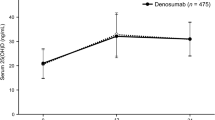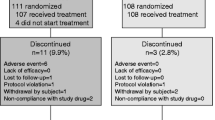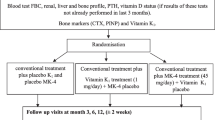Abstract
Summary
We investigated whether osteoporosis therapy with alendronate in postmenopausal patients is equally effective in patients who are vitamin D insufficient as in those who are vitamin D sufficient. We found that vitamin D insufficiency is common among patients with low bone density but that vitamin D insufficiency did not impair response to alendronate.
Introduction
Treatment of vitamin D deficiency leads to significant improvements in bone mineral density (BMD); however, whether insufficiency affects BMD’s response to bisphosphonate therapy is unknown.
Methods
To determine whether vitamin D insufficiency at initiation of alendronate therapy for low BMD affects treatment efficacy, we used data from 1,000 postmenopausal women randomly selected from the vertebral fracture arm (n = 2,027) of the placebo-controlled Fracture Intervention Trial of alendronate. Participants were randomly assigned to placebo (50%) or alendronate therapy and most (83%) to calcium (500 mg/day) and cholecalciferol (250 IU/day). We measured serum 25-hydroxy vitamin D (25OHD) at enrollment, then categorized baseline vitamin D status according to 25OHD concentration ( ≤ 10 ng/ml = deficient; >10 but ≤ 30 ng/ml = insufficient; >30 ng/ml = sufficient) and used linear regression to compare the effects of alendronate treatment among these categories.
Results and conclusion
At baseline, participants were vitamin D sufficient (14%), insufficient (83%), and deficient (2%). We found that BMD response to therapy at total hip or spine did not vary by vitamin D status at baseline (p for heterogeneity = 0.6). We determined that vitamin D insufficiency is common among participants with low BMD. However, vitamin D status at initiation of therapy does not affect BMD’s response to alendronate, when it is coadministered with cholecalciferol and calcium.


Similar content being viewed by others
References
Holick MF, Siris ES, Binkley N, Beard MK, Khan A, Katzer JT, Petruschke RA, Chen E, de Papp AE (2005) Prevalence of vitamin D inadequacy among postmenopausal North American women receiving osteoporosis therapy. J Clin Endocrinol Metab 90:3215–3224
Adamson BB, Gallacher SJ, Byars J, Ralston SH, Boyle IT, Boyce BF (1993) Mineralisation defects with pamidronate therapy for Paget’s disease. Lancet 342:1459–1460
Gibbs CJ, Aaron JE, Peacock M (1986) Osteomalacia in Paget’s disease treated with short term, high dose sodium etidronate. Br Med J (Clin Res Ed) 292:1227–1229
Koster JC, Hackeng WH, Mulder H (1996) Diminished effect of etidronate in vitamin D deficient osteopenic postmenopausal women. Eur J Clin Pharmacol 51:145–147
Antoniucci DM, Vittinghoff E, Blackwell T, Black DM, Sellmeyer DE (2005) Vitamin D insufficiency does not affect bone mineral density response to raloxifene. J Clin Endocrinol Metab 90:4566–4572
Deane A, Constancio L, Fogelman I, Hampson G (2007) The impact of vitamin D status on changes in bone mineral density during treatment with bisphosphonates and after discontinuation following long-term use in post-menopausal osteoporosis. BMC Musculoskelet Disord 8:3
Black DM, Reiss TF, Nevitt MC, Cauley J, Karpf D, Cummings SR (1993) Design of the fracture intervention trial. Osteoporos Int 3:S29–S39
Black DM, Cummings SR, Karpf DB, Cauley JA, Thompson DE, Nevitt MC, Bauer DC, Genant HK, Haskell WL, Marcus R, Ott SM, Torner JC, Quandt SA, Reiss TF, Ensrud KE (1996) Randomised trial of effect of alendronate on risk of fracture in women with existing vertebral fractures. Fracture Intervention Trial Research Group. Lancet 348:1535–1541
Cummings SR, Block G, McHenry K, Baron RB (1987) Evaluation of two food frequency methods of measuring dietary calcium intake. Am J Epidemiol 126:796–802
Hollis BW (2005) Circulating 25-hydroxyvitamin D levels indicative of vitamin D sufficiency: implications for establishing a new effective dietary intake recommendation for vitamin D. J Nutr 135:317–322
Heaney RP (2004) Functional indices of vitamin D status and ramifications of vitamin D deficiency. Am J Clin Nutr 80:1706S–1709S
Dawson-Hughes B, Heaney RP, Holick MF, Lips P, Meunier PJ, Vieth R (2005) Estimates of optimal vitamin D status. Osteoporos Int 16:713–716
Lips P (2001) Vitamin D deficiency and secondary hyperparathyroidism in the elderly: consequences for bone loss and fractures and therapeutic implications. Endocr Rev 22:477–501
Lips P, Duong T, Oleksik A, Black D, Cummings S, Cox D, Nickelsen T (2001) A global study of vitamin D status and parathyroid function in postmenopausal women with osteoporosis: baseline data from the multiple outcomes of raloxifene evaluation clinical trial. J Clin Endocrinol Metab 86:1212–1221
Villareal DT, Civitelli R, Chines A, Avioli LV (1991) Subclinical vitamin D deficiency in postmenopausal women with low vertebral bone mass. J Clin Endocrinol Metab 72:628–634
LeBoff MS, Kohlmeier L, Hurwitz S, Franklin J, Wright J, Glowacki J (1999) Occult vitamin D deficiency in postmenopausal US women with acute hip fracture. JAMA 281:1505–1511
Rucker D, Allan JA, Fick GH, Hanley DA (2002) Vitamin D insufficiency in a population of healthy western Canadians. CMAJ 166:1517–1524
Haden ST, Fuleihan GE, Angell JE, Cotran NM, LeBoff MS (1999) Calcidiol and PTH levels in women attending an osteoporosis program. Calcif Tissue Int 64:275–279
North American Menopause Society (2006) Management of osteoporosis in postmenopausal women: 2006 position statement of The North American Menopause Society. Menopause 13:340–367, quiz 368–349
National Osteoporosis Foundation (2000) Physician’s guide to prevention and treatment of osteoporosis. National Osteoporosis Foundation, Washington, DC
Hodgson SF, Watts NB, Bilezikian JP, Clarke BL, Gray TK, Harris DW, Johnston CC Jr., Kleerekoper M, Lindsay R, Luckey MM, McClung MR, Nankin HR, Petak SM, Recker RR, Anderson RJ, Bergman DA, Bloomgarden ZT, Dickey RA, Palumbo PJ, Peters AL, Rettinger HI, Rodbard HW, Rubenstein HA (2003) American Association of Clinical Endocrinologists medical guidelines for clinical practice for the prevention and treatment of postmenopausal osteoporosis: 2001 edition, with selected updates for 2003. Endocr Pract 9:544–564
Meunier PJ, Delmas PD, Eastell R, McClung MR, Papapoulos S, Rizzoli R, Seeman E, Wasnich RD (1999) Diagnosis and management of osteoporosis in postmenopausal women: clinical guidelines. International Committee for Osteoporosis Clinical Guidelines. Clin Ther 21:1025–1044
Hodgson SF, Watts NB, Bilezikian JP, Clarke BL, Gray TK, Harris DW, Johnston CC, Kleerekoper M, Lindsay R, Luckey MM, McClung MR, Nankin HR, Petak SM, Recker RR (2001) American Association of Clinical Endocrinologists 2001 medical guidelines for clinical practice for the prevention and management of postmenopausal osteoporosis. Endocr Pract 7:293–312
NIH Consensus Development Panel on Osteoporosis Prevention Diagnosis and Therapy (2001) Osteoporosis prevention, diagnosis, and therapy. JAMA 285:785–795
National Osteoporosis Foundation (2003) Physician’s guide to prevention and treatment of osteoporosis. National Osteoporosis Foundation, Washington, DC
Adams JS, Kantorovich V, Wu C, Javanbakht M, Hollis BW (1999) Resolution of vitamin D insufficiency in osteopenic patients results in rapid recovery of bone mineral density. J Clin Endocrinol Metab 84:2729–2730
Al-Ali H, Fuleihan GE (2000) Nutritional osteomalacia: substantial clinical improvement and gain in bone density posttherapy. J Clin Densitom 3:97–101
Dhingra RK, Sprague SM, Ojo AO, Leavey SF (2001) Posttransplant bone disease: a case illustrating dramatic improvements in bone density with vitamin D replacement therapy. Transplantation 71:1856–1859
Ettinger B, Black DM, Mitlak BH, Knickerbocker RK, Nickelsen T, Genant HK, Christiansen C, Delmas PD, Zanchetta JR, Stakkestad J, Gluer CC, Krueger K, Cohen FJ, Eckert S, Ensrud KE, Avioli LV, Lips P, Cummings SR (1999) Reduction of vertebral fracture risk in postmenopausal women with osteoporosis treated with raloxifene: results from a 3-year randomized clinical trial. Multiple Outcomes of Raloxifene Evaluation (MORE) Investigators. JAMA 282:637–645
Lufkin EG, Whitaker MD, Nickelsen T, Argueta R, Caplan RH, Knickerbocker RK, Riggs BL (1998) Treatment of established postmenopausal osteoporosis with raloxifene: a randomized trial. J Bone Miner Res 13:1747–1754
Delmas PD, Ensrud KE, Adachi JD, Harper KD, Sarkar S, Gennari C, Reginster JY, Pols HA, Recker RR, Harris ST, Wu W, Genant HK, Black DM, Eastell R (2002) Efficacy of raloxifene on vertebral fracture risk reduction in postmenopausal women with osteoporosis: four-year results from a randomized clinical trial. J Clin Endocrinol Metab 87:3609–3617
Heaney RP, Draper MW (1997) Raloxifene and estrogen: comparative bone-remodeling kinetics. J Clin Endocrinol Metab 82:3425–3429
Heaney RP, Davies KM, Chen TC, Holick MF, Barger-Lux MJ (2003) Human serum 25-hydroxycholecalciferol response to extended oral dosing with cholecalciferol. Am J Clin Nutr 77:204–210
Lips P, Chapuy MC, Dawson-Hughes B, Pols HA, Holick MF (1999) An international comparison of serum 25-hydroxyvitamin D measurements. Osteoporos Int 9:394–397
Binkley N, Krueger D, Cowgill CS, Plum L, Lake E, Hansen KE, DeLuca HF, Drezner MK (2004) Assay variation confounds the diagnosis of hypovitaminosis D: a call for standardization. J Clin Endocrinol Metab 89:3152–3157
Hollis BW, Kamerud JQ, Selvaag SR, Lorenz JD, Napoli JL (1993) Determination of vitamin D status by radioimmunoassay with an 125I-labeled tracer. Clin Chem 39:529–533
Conflict of interest
D.M.A., E.V., and D.E.S. have no conflicts of interest. L.P. consults for NPS D.M.B. receives lecture fees from Merck and has received grant support from Merck (1999–2004) and from Novartis (2000–present).
Author information
Authors and Affiliations
Corresponding author
Additional information
Scholar’s Grant from the National Osteoporosis Foundation (to D.M.A) and National Institutes of Health grant K23 RR020343 (to D.M.A).
Rights and permissions
About this article
Cite this article
Antoniucci, D.M., Vittinghoff, E., Palermo, L. et al. Vitamin D insufficiency does not affect response of bone mineral density to alendronate. Osteoporos Int 20, 1259–1266 (2009). https://doi.org/10.1007/s00198-008-0799-4
Received:
Accepted:
Published:
Issue Date:
DOI: https://doi.org/10.1007/s00198-008-0799-4




